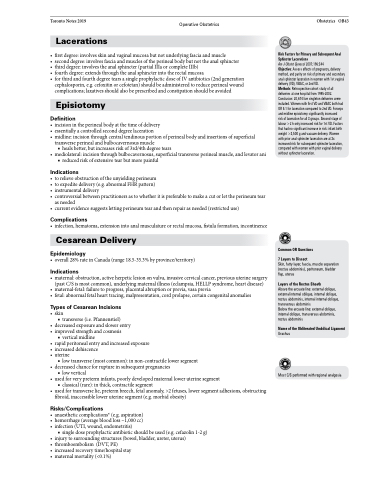Page 883 - TNFlipTest
P. 883
Toronto Notes 2019 Operative Obstetrics Lacerations
• firstdegree:involvesskinandvaginalmucosabutnotunderlyingfasciaandmuscle
• seconddegree:involvesfasciaandmusclesoftheperinealbodybutnottheanalsphincter
• thirddegree:involvestheanalsphincter(partialIIIaorcompleteIIIb)
• fourth degree: extends through the anal sphincter into the rectal mucosa
• for third and fourth degree tears a single prophylactic dose of IV antibiotics (2nd generation
cephalosporin, e.g. cefoxitin or cefotetan) should be administered to reduce perineal wound complications; laxatives should also be prescribed and constipation should be avoided
Episiotomy
Definition
• incisionintheperinealbodyatthetimeofdelivery
• essentiallyacontrolledseconddegreelaceration
• midline:incisionthroughcentraltendinousportionofperinealbodyandinsertionsofsuperficial
transverse perineal and bulbocavernosus muscle
■ heals better, but increases risk of 3rd/4th degree tears
• mediolateral:incisionthroughbulbocavernosus,superficialtransverseperinealmuscle,andlevatorani ■ reduced risk of extensive tear but more painful
Indications
• torelieveobstructionoftheunyieldingperineum
• toexpeditedelivery(e.g.abnormalFHRpattern)
• instrumentaldelivery
• controversialbetweenpractitionersastowhetheritispreferabletomakeacutorlettheperineumtear
as needed
• currentevidencesuggestslettingperineumtearandthenrepairasneeded(restricteduse)
Complications
• infection,hematoma,extensionintoanalmusculatureorrectalmucosa,fistulaformation,incontinence
Cesarean Delivery
Epidemiology
• overall28%rateinCanada(range18.5-35.3%byprovince/territory)
Indications
• maternal:obstruction,activeherpeticlesiononvulva,invasivecervicalcancer,previousuterinesurgery (past C/S is most common), underlying maternal illness (eclampsia, HELLP syndrome, heart disease)
• maternal-fetal:failuretoprogress,placentalabruptionorprevia,vasaprevia
• fetal:abnormalfetalhearttracing,malpresentation,cordprolapse,certaincongenitalanomalies
Types of Cesarean Incisions
• skin
■ transverse (i.e. Pfannenstiel)
• decreasedexposureandslowerentry
• improvedstrengthandcosmesis
■ vertical midline
• rapidperitonealentryandincreasedexposure
• increaseddehiscence
• uterine
■ low transverse (most common): in non-contractile lower segment
• decreasedchanceforruptureinsubsequentpregnancies
■ lowvertical
• usedforverypreterminfants,poorlydevelopedmaternalloweruterinesegment
■ classical (rare): in thick, contractile segment
• usedfortransverselie,pretermbreech,fetalanomaly,>2fetuses,lowersegmentadhesions,obstructing
fibroid, inaccessible lower uterine segment (e.g. morbid obesity)
Risks/Complications
• anaestheticcomplications*(e.g.aspiration) • hemorrhage(averagebloodloss~1,000cc) • infection(UTI,wound,endometritis)
■ single dose prophylactic antibiotic should be used (e.g. cefazolin 1-2 g) • injurytosurroundingstructures(bowel,bladder,ureter,uterus)
• thromboembolism (DVT, PE)
• increasedrecoverytime/hospitalstay
• maternalmortality(<0.1%)
Obstetrics OB43
Risk Factors for Primary and Subsequent Anal Sphincter Lacerations
Am J Obstet Gynecol 2007;196:344
Objective: Assess effects of pregnancy, delivery method, and parity on risk of primary and secondary anal sphincter laceration in women with 1st vaginal delivery (VD), VBAC, or 2nd VD.
Methods: Retrospective cohort study of all deliveries at one hospital from 1995-2002. Conclusion: 20,674 live singleton deliveries were included. Women with first VD and VBAC both had OR 5.1 for laceration compared to 2nd VD. Forceps and midline episiotomy significantly increased
risk of laceration for all 3 groups. Second stage of labour >2 h only increased risk for 1st VD. Factors that had no significant increase in risk: infant birth weight >3,500 g and vacuum delivery. Women with prior anal sphincter laceration are at 3x increased risk for subsequent sphincter laceration, compared with women with prior vaginal delivery without sphincter laceration.
Common OR Questions
7 Layers to Dissect
Skin, fatty layer, fascia, muscle separation (rectus abdominis), peritoneum, bladder flap, uterus
Layers of the Rectus Sheath
Above the arcuate line: external oblique, external internal oblique, internal oblique, rectus abdominis, internal internal oblique, transversus abdominis
Below the arcuate line: external oblique, internal oblique, transversus abdominis, rectus abdominis
Name of the Obliterated Umbilical Ligament
Urachus
Most C/S performed with regional analgesia


